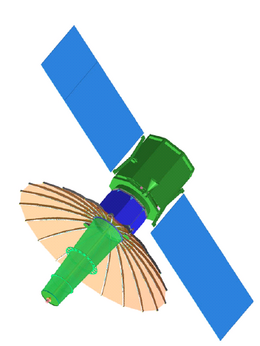TacSat-4
 Computer model of TacSat-4 | |
| Mission type | Technology |
|---|---|
| Operator | NRL APL AFRL |
| COSPAR ID | 2011-052A |
| SATCAT no. | 37818 |
| Spacecraft properties | |
| Launch mass | 460 kilograms (1,010 lb) |
| Start of mission | |
| Launch date | September 27, 2011 |
| Rocket | Minotaur IV |
| Launch site | Kodiak Pad 1 |
| Contractor | Orbital |
| Orbital parameters | |
| Reference system | Geocentric |
TacSat-4 is the fourth in a series of U.S. military experimental reconnaissance and communication satellites. The Naval Research Laboratory (NRL) is the program manager. The Office of Naval Research (ONR) sponsored the development of the payload and funded the first year of operations. The Office of the Director of Defense Research and Engineering (DDR&E) funded the standardized spacecraft bus and the Operationally Responsive Space Office (ORS) funded the launch that will be performed by the Air Force’s Space and Missile Systems Center (SMC).
The spacecraft was completed by the end of 2009, and was launched on September 27, 2011, on a Minotaur IV rocket into a highly elliptical orbit.[1][2][3][4]
Mission
TacSat-4 is equipped with a 3.8 m (12 ft) antenna operating 10 Ultra High Frequency (UHF) channels that can be used for any combination of communications, data ex-filtration or Blue Force Tracking (BFT). TacSat-4 will fly the highly elliptical, 4-hour, orbit (12,050 kilometers at peak) providing typical payload communication periods of two hours per orbit. TacSat-4’s orbit also allows it to cover the high latitudes.
Part of its capability is rapid (within 24 hours) reallocation to different theaters worldwide, in support of unexpected operations. Command and control of TacSat-4 will be performed at the NRL Satellite Operations Center at Blossom Point, Maryland. Payload tasking will be performed via the SIPRNet based Virtual Mission Operations Center (VMOC).
Design
All TacSat satellites are designed to demonstrate the ability to provide real-time data collected from space to combatant commanders in the field.[5]
The spacecraft bus was built by NRL and Johns Hopkins University Applied Physics Laboratory (APL) to mature ORS bus standards developed by an Integrated (government and industry) System Engineering Team, the “ISET Team,” with active representation from AeroAstro, Air Force Research Laboratory, Johns Hopkins Laboratory APL, ATK Space, Ball Aerospace & Technologies, Boeing, Design Net Engineering, General Dynamics AIS, Microcosm, Sierra Nevada Corp., Massachusetts Institute of Technology, Lincoln Laboratory, Orbital Sciences, NRL, SMC, Space Systems/Loral, and Raytheon. Li ion battery power provided by Quallion.
Gallery
 |
 |
 |
 |
References
- ^ "Next launch: May 5". Kodiak Daily Mirror. March 1, 2011. Retrieved March 9, 2011.
- ^ "TacSat-4 spacecraft complete and awaiting launch". Naval Research Laboratory. December 1, 2009. Retrieved June 13, 2010.
- ^ "Worldwide launch schedule". Spaceflight Now. June 15, 2010. Retrieved June 16, 2010.
- ^ Brinton, Turner (August 30, 2010). "Rapidly Delivered Systems". SPACE NEWS. Retrieved October 25, 2010.
- ^ Ferster, Warren (November 7, 2005). "U.S. Air Force Payload for TacSat 4". Space News. Archived from the original on May 15, 2008. Retrieved July 28, 2008.
{{cite web}}: Unknown parameter|deadurl=ignored (|url-status=suggested) (help)
External links
- TacSat-4 (Tactical Satellite-4), eoPortal, on the eo "Sharing Earth Observation Resources" website.
